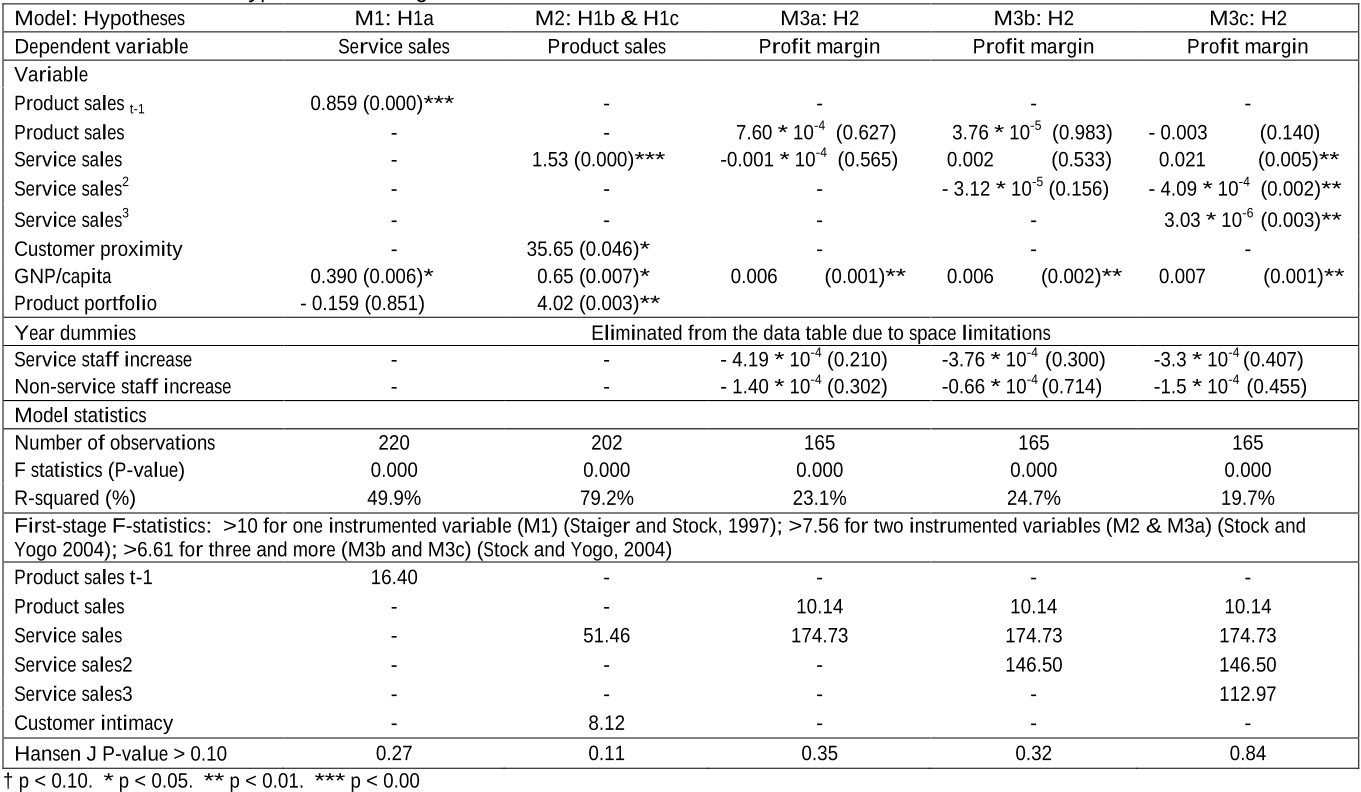Servitization: Disentangling the impact of service business model innovation on manufacturing firm performance
TLDR
In this paper, the authors analyzed the value creation and value appropriation processes of 44 national subsidiaries of a global manufacturing firm turned product-service provider, in the 2001-2007 period, and found that the firm under study is able to successfully transcend the inherent substitution of products by services and to enact complementary sales dynamics between the two activities.About:
This article is published in Journal of Operations Management.The article was published on 2013-05-01 and is currently open access. It has received 584 citations till now. The article focuses on the topics: Service (business) & Profitability index.read more
Figures

Table 3. Results from Hypotheses Testing 
Figure 1. Relationship between service scale and subsidiary profit margin* 
Table 1.a Overview of the variables and their use 
Table 1.a Overview of the variables and their use 
Table 2. Summary statistics and correlation coefficient No Variable Obs Mean SD Min Max 1 2 3 4 5 6 7 8 9 10 11 12 13 14
Citations
More filters
Journal ArticleDOI
A history-based framework of servitization and deservitization
TL;DR: In this paper, the authors developed a history-based framework of servitization and deservitization, which predicts that deservittization outperforms servitisation in mature servitized industries to the extent that such pivots are restorative in nature.
Journal ArticleDOI
Worth the risk? The profit impact of outcome-based service offerings for manufacturing firms
Lauri Korkeamäki,Lauri Korkeamäki,Marko Kohtamäki,Marko Kohtamäki,Marko Kohtamäki,Vinit Parida,Vinit Parida,Vinit Parida +7 more
TL;DR: In this article, the authors found that an average outcome-based service provider has a 4.40 percent higher gross margin than an average non-OBS provider and that large OBS providers generate lower profits.
Journal ArticleDOI
Using Data in Decision‐Making: Analysis from the Music Industry
TL;DR: In this paper, the authors present an analysis of the meaning of the data and how erroneous conclusions may be drawn, which could adversely affect future decisions made by managers and policy makers.
Proceedings Article
Business Model Innovation Strategies for Product Service Systems – An Explorative Study in the Manufacturing Industry
TL;DR: In this article, the authors analyzed reoccurring product service system (PSS) business model patterns as well as innovation strategies to transform from one pattern to another, i.e., product-oriented manufacturing, use-oriented enabling and result-oriented service offering.
Journal ArticleDOI
Roles of leadership styles and relationship-based employee governance in open service innovation: Evidence from Malaysian service sector
TL;DR: In this paper, the authors investigated the relationship of leadership styles (paternalistic, authentic and democratic) with relationship-based employee governance and open service innovation in the Malaysian healthcare sector.
References
More filters
Book ChapterDOI
Firm Resources and Sustained Competitive Advantage
TL;DR: In this article, the authors examined the link between firm resources and sustained competitive advantage and analyzed the potential of several firm resources for generating sustained competitive advantages, including value, rareness, imitability, and substitutability.
Book
Econometric Analysis of Cross Section and Panel Data
TL;DR: This is the essential companion to Jeffrey Wooldridge's widely-used graduate text Econometric Analysis of Cross Section and Panel Data (MIT Press, 2001).
Journal ArticleDOI
Dynamic capabilities and strategic management
TL;DR: The dynamic capabilities framework as mentioned in this paper analyzes the sources and methods of wealth creation and capture by private enterprise firms operating in environments of rapid technological change, and suggests that private wealth creation in regimes of rapid technology change depends in large measure on honing intemal technological, organizational, and managerial processes inside the firm.
Journal ArticleDOI
Some Tests of Specification for Panel Data: Monte Carlo Evidence and an Application to Employment Equations.
Manuel Arellano,Stephen Bond +1 more
TL;DR: In this article, the generalized method of moments (GMM) estimator optimally exploits all the linear moment restrictions that follow from the assumption of no serial correlation in the errors, in an equation which contains individual effects, lagged dependent variables and no strictly exogenous variables.
Related Papers (5)
Exploring the financial consequences of the servitization of manufacturing
Andy Neely,Andy Neely +1 more